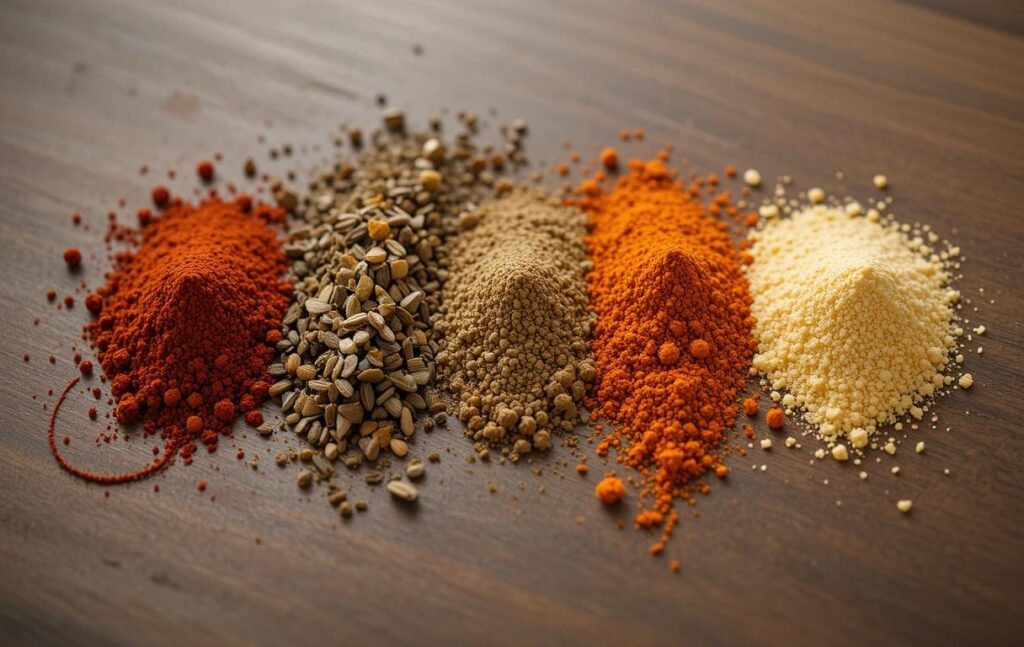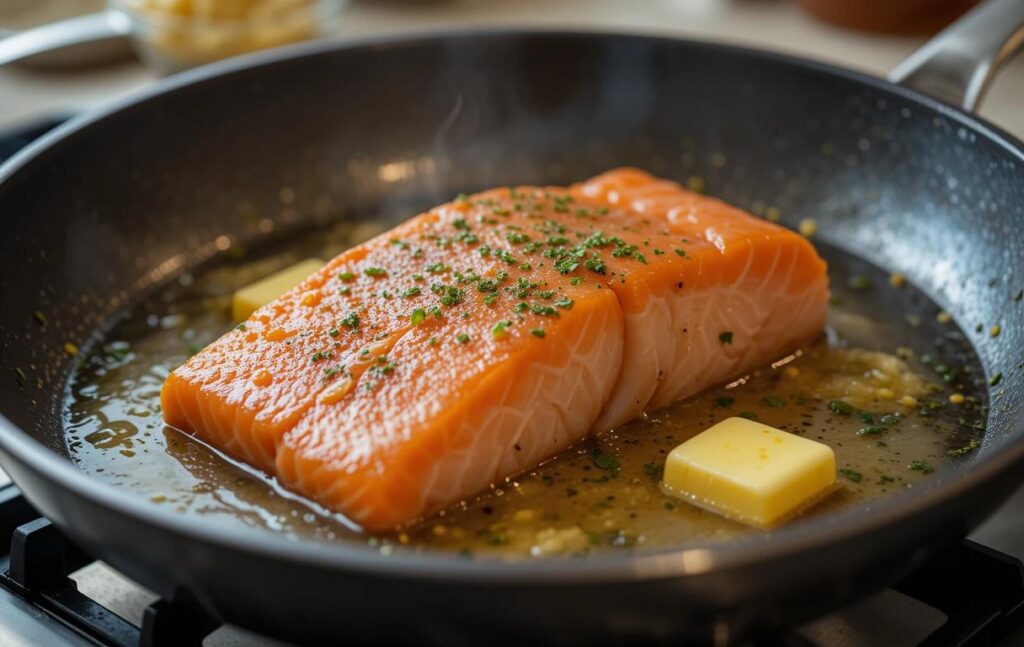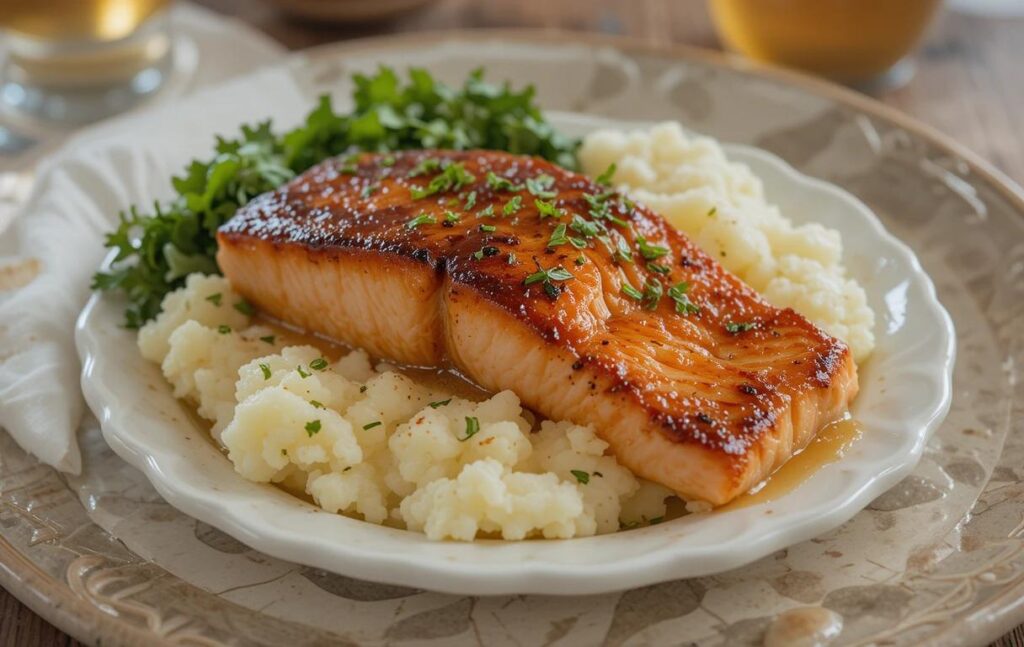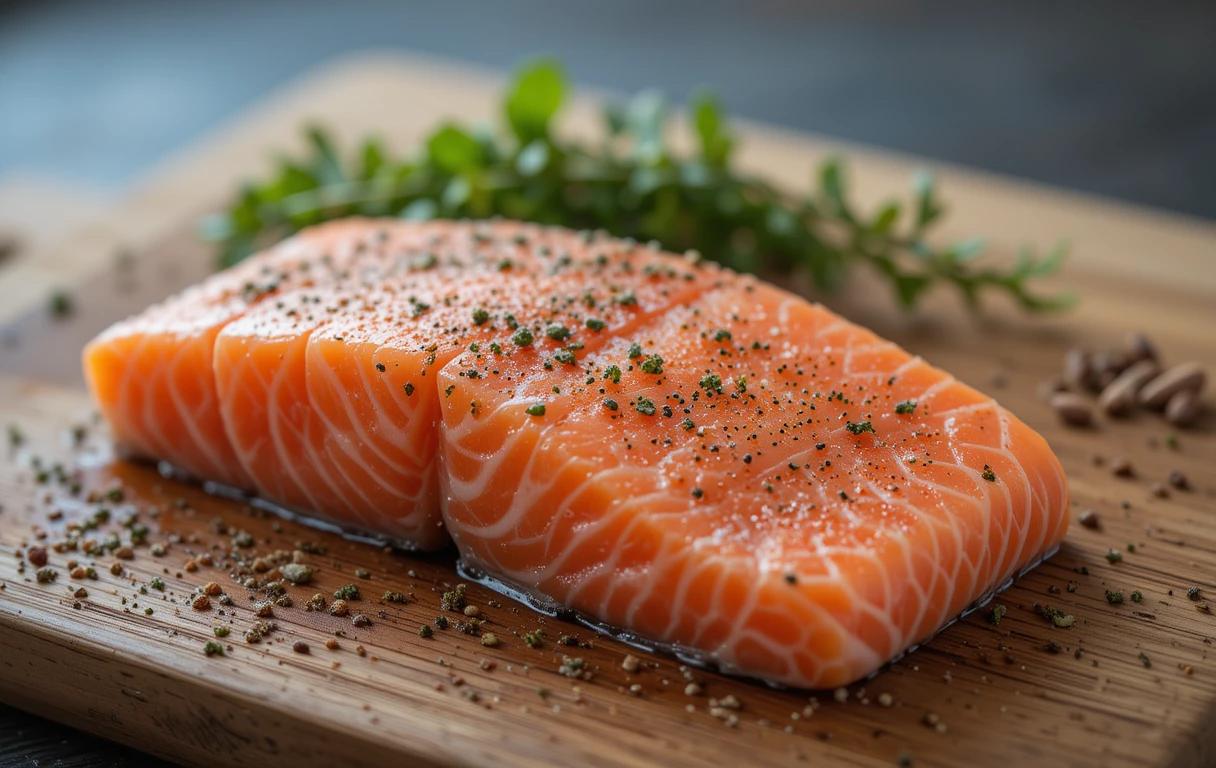What Gordon Ramsay put on salmon?
What Gordon Ramsay Put on Salmon: A Culinary Insight
Gordon Ramsay is known for transforming simple dishes into culinary masterpieces, and salmon is no exception. His approach to cooking salmon highlights his signature blend of simplicity, precision, and bold flavors. From the selection of premium ingredients to his meticulous preparation techniques, Ramsay’s methods guarantee a restaurant-quality dish every time. So, what does Gordon Ramsay put on salmon to elevate it to perfection? This article delves into his secrets, from seasoning choices to cooking techniques, ensuring you can recreate his famous salmon dish at home.
Salmon, a versatile and nutrient-rich fish, holds a special place in Ramsay’s repertoire. Whether it’s seared to perfection or paired with complementary sides, his recipes are a testament to the balance between sophistication and accessibility. Let’s explore how Gordon Ramsay brings out the best in this culinary staple.
Gordon Ramsay’s Approach to Cooking Salmon
Cooking salmon is both an art and a science for Gordon Ramsay. He emphasizes letting the natural flavors of the fish shine through by focusing on high-quality ingredients, straightforward techniques, and attention to detail. Ramsay believes that simplicity is key, and overcomplicating the recipe can mask the salmon’s delicate taste.
His philosophy also includes balancing flavors, textures, and visual appeal. For example, achieving a crispy skin while keeping the interior moist and flaky is one of Ramsay’s hallmarks. This ensures that every bite of the dish is as delicious as it is satisfying.
1 Why Salmon Is a Signature Dish
Salmon is a staple in Ramsay’s kitchens due to its versatility and health benefits. Rich in omega-3 fatty acids, it’s a heart-healthy choice packed with flavor. Whether you’re pan-searing, baking, or grilling, salmon adapts beautifully to various cooking methods and flavor profiles.
Ramsay often highlights the accessibility of salmon as a reason for its popularity. It’s a fish that’s widely available, easy to prepare, and pairs well with a variety of herbs, spices, and sides. Its vibrant color and rich texture make it a favorite for both home cooks and professional chefs.
2 Ramsay’s Preferred Salmon Varieties
When it comes to selecting salmon, Gordon Ramsay opts for the best quality available. He often prefers wild-caught salmon, such as Alaskan or Scottish varieties, due to their robust flavor and firmer texture. Wild salmon tends to have a richer color and fewer artificial additives compared to farmed options.
However, Ramsay acknowledges that farmed salmon can be a viable alternative if sourced responsibly. Sustainability is a crucial aspect of his philosophy, and he advocates for choosing salmon from certified sustainable fisheries to support environmental conservation.
2. Ingredients Used by Gordon Ramsay on Salmon

One of the defining aspects of Gordon Ramsay’s cooking is his ability to elevate simple ingredients into a harmonious and flavorful dish. When preparing salmon, Ramsay focuses on a combination of essential seasonings, fresh herbs, and complementary sauces or marinades to enhance the fish’s natural taste.
1 Seasoning Basics
At the core of Ramsay’s salmon preparation are simple yet effective seasonings:
- Salt and Pepper: Ramsay starts with a generous but balanced sprinkle of sea salt and freshly ground black pepper. These seasonings form the foundation for enhancing the salmon’s natural flavor without overpowering it.
- Olive Oil: A light drizzle of high-quality olive oil adds moisture, prevents sticking, and helps achieve a beautiful golden sear.
- Paprika (Optional): For a slight smokiness and color, Ramsay sometimes incorporates a dash of paprika, particularly when pan-searing.
This minimalist approach ensures the salmon’s delicate flavors remain at the forefront while laying a versatile base for additional ingredients.
2 Aromatics and Herbs
Fresh aromatics and herbs are central to Ramsay’s salmon dishes. Some of his favorites include:
- Dill: Known for its fresh and slightly sweet flavor, dill pairs exceptionally well with salmon, adding a refreshing contrast to its richness.
- Parsley: Chopped parsley adds a touch of earthiness and enhances the dish’s color.
- Garlic: Minced garlic infuses a subtle depth of flavor, particularly when used in marinades or sautéed alongside the fish.
- Lemon Zest: A sprinkle of lemon zest brightens the dish, cutting through the salmon’s richness with a citrusy kick.
These aromatics are carefully selected to complement the salmon rather than overpower it, maintaining a balance that’s key to Ramsay’s style.
3 Signature Sauces and Marinades
Gordon Ramsay often uses simple yet sophisticated sauces or marinades to enhance his salmon dishes. A few popular options include:
- Honey and Soy Glaze: A mixture of honey, soy sauce, and a hint of garlic creates a sticky glaze that caramelizes beautifully on the salmon’s surface.
- Mustard-Based Marinade: Dijon mustard combined with olive oil, lemon juice, and fresh herbs creates a tangy and aromatic marinade.
- Lemon Butter Sauce: Melted butter infused with lemon juice and parsley is often drizzled over the salmon just before serving for added richness.
These additions are designed to complement the salmon’s flavor profile while introducing layers of complexity.
How Gordon Ramsay Cooks Salmon

The way Gordon Ramsay cooks salmon showcases his expertise in balancing flavor, texture, and presentation. His techniques ensure a dish that is crispy on the outside and tender on the inside, allowing the natural taste of the salmon to shine.
1 Preparing the Salmon
Ramsay emphasizes the importance of preparation before cooking. Here’s how he does it:
- Trimming and Deboning: He carefully inspects the fillet, using tweezers to remove any remaining bones and trims uneven edges to ensure uniform cooking.
- Patting Dry: Ramsay always pats the salmon dry with a paper towel. This step is crucial for achieving a crispy skin during cooking.
- Scoring the Skin: Lightly scoring the skin allows the heat to penetrate evenly and prevents the fillet from curling in the pan.
- Seasoning: After preparing the salmon, he seasons generously with sea salt and black pepper, focusing on the skin side to enhance its crispiness.
Chef’s Tip: Let the salmon rest at room temperature for 10–15 minutes before cooking to ensure even heat distribution.
2 Pan-Seared Salmon Technique
Ramsay’s most celebrated method of cooking salmon is pan-searing. Here’s how he perfects it:
- Preheating the Pan: He starts with a hot, non-stick pan and adds a small amount of olive oil to coat the surface.
- Cooking Skin-Side Down: The salmon is placed skin-side down in the pan. Ramsay applies gentle pressure with a spatula for the first 30 seconds to ensure the skin makes full contact with the pan, which helps it crisp up.
- Timing: He sears the skin side for 2–3 minutes on medium heat until it’s golden brown and crispy.
- Flipping: Ramsay flips the salmon and cooks the flesh side for 1–2 minutes to maintain a moist interior.
- Butter Basting: A knob of butter, a sprig of thyme, and a clove of garlic are added to the pan. He tilts the pan slightly and uses a spoon to baste the salmon with the melted butter for extra flavor and richness.
Chef’s Tip: Ramsay advises cooking salmon to medium-rare for the best texture and flavor. Overcooking can dry out the fish and diminish its delicate taste.
3 Alternative Methods
While pan-searing is his go-to technique, Ramsay also explores other methods depending on the desired flavor profile:
- Baking: Perfect for larger fillets or whole salmon, baking is a hands-off method that ensures even cooking. Ramsay often wraps the salmon in parchment paper with herbs and lemon slices for a steamed effect.
- Grilling: For a smoky, charred flavor, Ramsay grills salmon fillets over medium-high heat, brushing them with olive oil to prevent sticking.
- Poaching: A gentle cooking method, poaching in a flavorful broth of white wine, garlic, and herbs ensures a soft, moist texture.
Presentation and Plating Tips

For Gordon Ramsay, the way a dish is presented is just as important as how it tastes. His plating techniques elevate salmon dishes to restaurant-quality levels, focusing on balance, color, and artistic appeal. Ramsay believes every plate should tell a story, and salmon, with its vibrant hue, offers a perfect canvas for creative presentation.
1 Side Dish Pairings
To complement salmon’s rich and delicate flavor, Ramsay pairs it with sides that provide contrast in texture and taste. Some of his favorite side dishes include:
- Seasonal Vegetables: Lightly roasted asparagus, sautéed spinach, or glazed carrots add freshness and vibrant color.
- Risotto: Creamy lemon or pea risotto pairs beautifully with the flaky texture of salmon, offering a luxurious feel.
- Mashed Potatoes or Purees: Buttery mashed potatoes or parsnip puree provide a smooth and comforting base.
- Quinoa or Wild Rice: For a lighter option, Ramsay often recommends pairing salmon with grain-based sides, which add nutty flavors and chewy textures.
Chef’s Tip: Balance the richness of salmon with tangy or zesty sides like a citrus-dressed salad or pickled vegetables.
2 Garnishing with Elegance
Ramsay’s garnishing style focuses on simplicity and natural beauty. Here are his key tips:
- Microgreens and Fresh Herbs: A sprinkle of microgreens or finely chopped dill enhances the plate’s freshness.
- Lemon Wedges: Adding lemon wedges not only improves presentation but also offers diners the option to adjust the citrus flavor.
- Edible Flowers: For special occasions, edible flowers like nasturtiums or pansies can create a stunning visual impact.
- Drizzles and Dots: Ramsay sometimes uses sauces like balsamic glaze or herb oil to create artistic patterns on the plate, adding flair and sophistication.
Chef’s Tip: Keep garnishes minimal and intentional, ensuring they enhance the dish without cluttering the plate.
3 Plating Tips from Ramsay
When plating salmon, Ramsay advises paying attention to structure and balance:
- Use the Rule of Thirds: Position the salmon slightly off-center, with sides and garnishes arranged asymmetrically for visual appeal.
- Layer Textures: Stack components like mashed potatoes or grains under the salmon to create height and dimension.
- Clean Edges: Wipe the plate edges clean for a professional finish.
By focusing on these details, Ramsay ensures his dishes are Instagram-worthy and ready to impress.
Frequently Asked Questions
Here are some of the most common questions about Gordon Ramsay’s salmon preparation, along with helpful answers to guide you in recreating his techniques.
1 Does Gordon Ramsay Marinate His Salmon?
Gordon Ramsay occasionally marinates salmon, but only lightly to preserve its natural flavor. A simple mix of olive oil, lemon juice, fresh herbs, and garlic is used for a quick marinade, usually for 15–20 minutes. Ramsay prefers to rely on the fish’s inherent taste, enhancing it with seasoning and fresh ingredients rather than masking it with heavy marinades.
2 Can You Use Farmed Salmon Instead of Wild-Caught?
While Gordon Ramsay favors wild-caught salmon for its robust flavor and firm texture, he acknowledges that high-quality farmed salmon can be a suitable alternative. The key is to ensure the source is sustainable and ethical. Look for certifications such as MSC (Marine Stewardship Council) or ASC (Aquaculture Stewardship Council) to make an environmentally friendly choice.
3 What Sides Complement Gordon Ramsay’s Salmon?
Ramsay often pairs salmon with light, fresh sides to balance its richness. Examples include roasted asparagus, creamy mashed potatoes, or a zesty quinoa salad. For a more decadent pairing, he recommends creamy risotto or buttery parsnip puree.
4 How Does Gordon Ramsay Ensure Crispy Salmon Skin?
To achieve a crispy skin, Ramsay always ensures the salmon is patted dry before cooking. He then uses a hot, non-stick pan and starts cooking skin-side down, applying gentle pressure with a spatula to maintain full contact with the pan. Adding a small amount of oil and cooking on medium heat ensures an even, golden-brown finish.
5 What Type of Oil Does Gordon Ramsay Use?
Ramsay typically uses olive oil for cooking salmon due to its mild flavor and ability to withstand moderate heat. For high-heat cooking, such as grilling, he sometimes opts for neutral oils like grapeseed or avocado oil to prevent smoking.
6 How Can Beginners Recreate Ramsay’s Salmon Recipe?
For beginners, Ramsay recommends starting with the pan-searing technique. Use a fresh salmon fillet, season with salt and pepper, and follow the steps for crispy skin. Pair the salmon with simple sides like steamed vegetables and a lemon butter sauce to keep the preparation straightforward yet delicious.
Conclusion
Cooking salmon like Gordon Ramsay is a journey of mastering simplicity, precision, and bold flavors. By focusing on high-quality ingredients, thoughtful seasoning, and expert cooking techniques, Ramsay transforms salmon into a showstopping dish that’s both elegant and approachable. Whether it’s a weeknight meal or a special occasion, his methods are designed to elevate your culinary skills and impress your guests.
Now that you know what Gordon Ramsay puts on salmon, it’s time to bring these techniques into your own kitchen. Experiment with his recipes, get creative with presentation, and enjoy the process of making a meal that’s worthy of a world-class chef.
Recipe: Maple Salmon
Related Recipes
- “Tuna Tomato Sauce Pasta Recipe“: A tomato-based recipe showcasing another way to use tomatoes.
- “Baked Chicken Fettuccine Alfredo with Broccoli“: Another comforting dish that can be complemented with tomato-based sauces.
Ingredient-Focused Content
- “Lions Mane Mushroom Recipe“: Suggest using a tomato gravy as a flavorful addition for plant-based dishes.
Cooking Techniques and Enhancements
- “Mango Habanero Salsa“: Explore complementary uses of sauces and gravies for flavor diversity.
Storage and Reuse Tips
- “Sous Vide Recipes“: Recommend tomato gravy as a sauce for sous vide-cooked meats or vegetables.
- “Ocean Spray Cranberry Sauce Recipe“: Guide readers on making and storing sauces, including tomato gravy.

